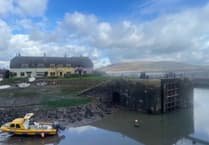AN area of buried prehistoric woodland, plant, and insect remains has been discovered on Exmoor on land cared for by the National Trust.
The findings were unearthed during a year-long peatland restoration project at the charity’s Holnicote Estate in partnership with the South West Peatland Partnership (SWPP) to improve the health of degrading peatlands across the Westcountry.
The project has provided a rare glimpse into a Neolithic and Bronze Age landscape and will help to inform plans for further landscape restoration.
SWPP received funding two years ago from Natural England’s Nature for Climate peatland grant scheme with match funding provided by South West Water, the Duchy of Cornwall, National Trust, and Cornwall Council for work across Exmoor, Dartmoor, and Cornwall.

The Holnicote work included constructing leaky log dams to help slow the flow of water through the valley and to improve water quality.
The higher, more stable water table within the peat will also help to reduce carbon emissions and to increase the resilience of the landscape to climate change as well as preserving archaeology.
The woodland and insect remains, dating to between the Neolithic and Bronze Ages, were found preserved in a peatland ‘time capsule’ taken from an area on the estate called Alderman’s Barrow Allotment.
The area is named after a Bronze Age barrow and also features the remains of two prehistoric round houses within a few hundred yards of the restoration work, one of which is terraced into the hillside overlooking the base of the valley where the woodland once stood.

The ‘time capsule’ provided a snapshot of when and how the peat formed, as well as the kinds of species of plants and insects which lived in the landscape, many of which still live in similar wet woodland areas today.
Samples were taken at two-inch intervals to create a five feet deep sequence of peat, which was taken to a specialist Wessex Archaeology laboratory in Salisbury to be analysed.
Discoveries included more than 100 fragments of Hydraena riparia beetles, a semi-aquatic beetle which flourishes in damp conditions and still exists today, and prehistoric samples of dung beetles, rove beetles, moss mites, and water scavenger beetles.
Remains from a prehistoric woodland floor comprising fragments of trunks, small branches, and twigs were found to date from about 4,500 to 3,500 years ago during the late Neolithic and middle Bronze Age (2860–2570 Cal BC to 1400–1220 Cal BC).
The fragments revealed the presence of tree species including alder and willow, with evidence of birch growing nearby, indicated by seeds.
After careful removal and analysis, woodland remains from other parts of the site, such as a segment of willow tree, were found to date from as early as the beginning of the Neolithic (3940-3650 Cal BC).

Plant remains also recovered from the peat indicated sedges and rushes were growing within the wet woodland habitat, while birch and oak were present in the wider surrounding landscape.
National Trust area ranger Basil Stow said: “We are really excited about these findings.
“It is great to think that the discovery of the prehistoric insect and woodland remains provides an opportunity to understand the vegetation and the natural processes which helped establish this thriving wet, peaty, environment many thousands of years ago.
“Crucially, all of this information will help inform how we manage the landscape now and in the future.
“During this phase of restoration work we have created larger areas of wetland pools with woody dams.”
Wessex Archaeology senior environmental archaeologist Dr Ed Treasure, who specialises in plant remains and wood, said: “These discoveries provide a unique and tangible way of connecting with Exmoor’s past, and they illustrate the changing nature of landscapes and reveal how this impressive landscape came to be.
“We can use this information to develop a ‘baseline’ for peatland restoration studies which can extend back centuries, if not millennia.
“This long-term view enables us to look beyond many of the significant changes in land-use practices in peatlands which occurred during the last few centuries.”
Natural England senior historic environment adviser for peatlands Kat Hopwood-Lewis said: “The Nature for Climate peatland grant funding is designed to protect archaeology during restoration work and we are thrilled to see new discoveries that help us to better understand and restore our precious peatlands.
“The peatland restoration work will also allow the peat to continue its role preserving valuable archaeology and paleoenvironmental remains to help build an understanding of the past environment and our interactions with it over thousands of years.”
SWPP historic environment officer Phil Wright said: “Despite being thousands of years old, the fragments of wood look like they could have been buried yesterday, thanks to the way peat acts as a natural preserver.
“Peat contains very little oxygen, which means that organic materials like wood can survive for thousands of years if the peat remains in good condition.

“Finding such well-preserved evidence for past woodland cover can help us to re-imagine the landscape in which people lived and constructed monuments thousands of years ago.
“The remains also have the potential to answer questions about contributing affects of climate change and woodland clearance to the decline of woodland in the later prehistoric period.”
National Trust archaeologist Jim Parry said: “Peatlands are incredible environments that humans have used for thousands of years, their special properties helping preserve history under our feet.
“In helping to restore and protect peatlands and prevent them from cracking and eroding, we are helping to ensure that this valuable finite archive of history will not crumble and wash away
“Climate change is threatening to destroy untold treasures buried in the UK as the soils that protect them dry out, so peatland conservation is vital for preserving our past as well as our future.”



